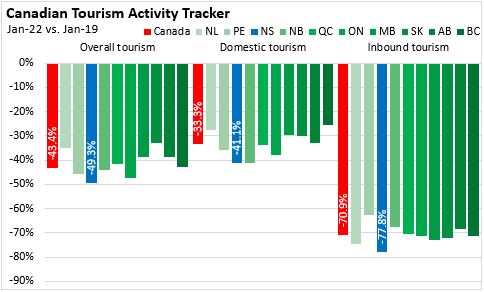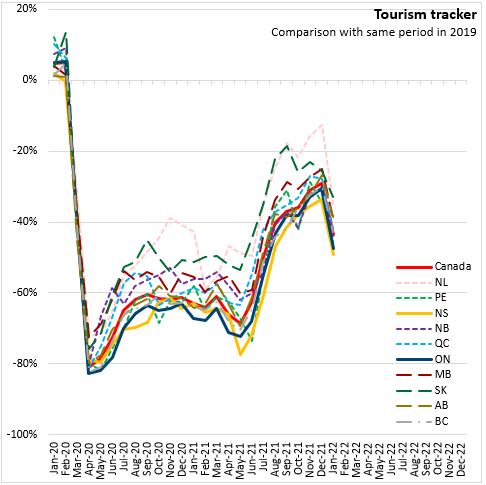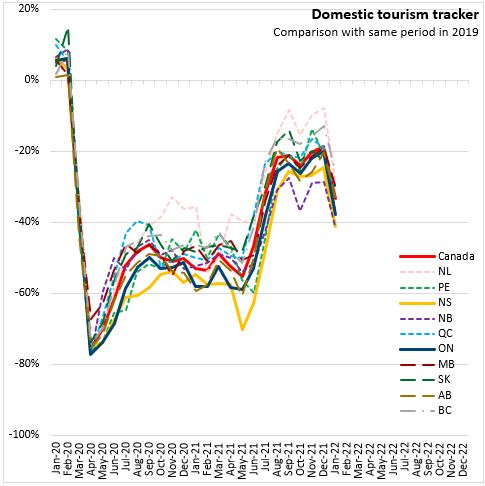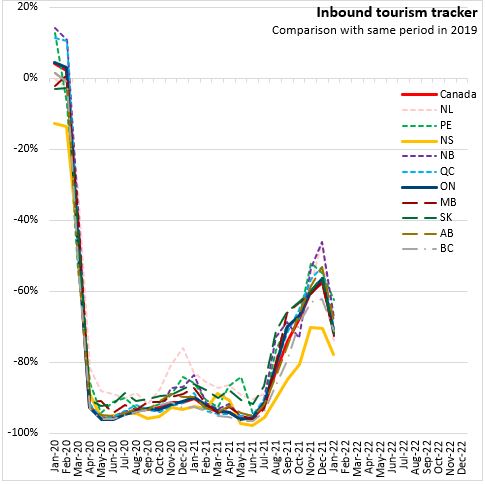The Economics and Statistics Division maintains archives of previous publications for accountability purposes, but makes no updates to keep these documents current with the latest data revisions from Statistics Canada. As a result, information in older documents may not be accurate. Please exercise caution when referring to older documents. For the latest information and historical data, please contact the individual listed to the right.
<--- Return to Archive
For additional information relating to this article, please contact:
April 04, 2022TOURISM ACTIVITY TRACKER, JANUARY 2022 Statistics Canada's "Canadian Tourism Activity Tracker" illustrates the impacts of the COVID-19 pandemic on tourism activity. The data compares the latest reference period (January 2022) and the same period in 2019, prior to the pandemic. This provides a snapshot of how tourism activity has changed, including air travel, surface travel, hotels/accommodations, spending and trip duration. Tourism activity is monitored for both domestic travellers (those travelling within Canada, including within province more than 40 km from home) as well as inbound travellers from international sources. Overall tourism is estimated as a weighted average of domestic and inbound tourism activities.
With the emergence of the Omicron variant in December, the federal government advised against all non-essential travel outside of the country and required a negative PCR test for all travellers entering Canada. Many provinces delayed re-opening plans. After several months of recovery, the improvement in tourism activity reversed across the country.
In January 2022, Nova Scotia's tourism activity was 49.3% below January 2019 levels. Domestic tourism activity was 41.1% below January 2019 levels. International inbound tourism activity in Nova Scotia was 77.8% below January 2019 levels. This was the largest decline among the provinces for all types of tourism activity.
Overall tourism activity in Canada was down 43.4% compared to January 2019. Both domestic and international inbound tourism activity declined in all provinces in January 2022. Newfoundland and Labrador (-34.8%) and Manitoba (-32.9%) report the least declines while Ontario (-47.4%) and Nova Scotia report the largest declines.

With travel and activity restrictions at the start of the COVID-19 pandemic, tourism activity fell dramatically in all provinces. Activity partially recovered in the summer and fall of 2020, as domestic tourism started to grow again (international inbound tourism remained well below 2019 levels). Additional restrictions and travel limitations in the spring of 2021 reduced tourism activity again, particularly domestic tourism. As restrictions were eased in the summer of 2021, there was a sharp rebound in tourism activity across all provinces, driven primarily by domestic tourism. Tourism activity had been recovering at a slower pace since the summer of 2021 to December. With the emergence of the Omicron variant and reinstatement of restrictions, tourism activity fell in January 2022.



Source: Statistics Canada. Table 24-10-0049-01 Canadian Tourism Activity Tracker and Grouped Data Sources, Canadian Tourism Activity Tracker
<--- Return to Archive